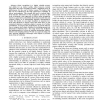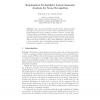129
Voted
CVPR
2012
IEEE
13 years 2 months ago
2012
IEEE
In this paper we present the first large-scale scene attribute database. First, we perform crowd-sourced human studies to find a taxonomy of 102 discriminative attributes. Next,...
114
Voted
CVPR
2012
IEEE
13 years 2 months ago
2012
IEEE
The problem of simultaneous feature extraction and selection, for classifier design, is considered. A new framework is proposed, based on boosting algorithms that can either 1) s...
112
Voted
ICCV
2011
IEEE
14 years 12 days ago
2011
IEEE
This paper presents a novel approach to utilizing high level knowledge for the problem of scene recognition in an active vision framework, which we call active scene recognition. ...
125
Voted
ICCV
2011
IEEE
14 years 12 days ago
2011
IEEE
Weakly supervised discovery of common visual structure in highly variable, cluttered images is a key problem in recognition. We address this problem using deformable part-based mo...
131
click to vote
PAMI
2011
14 years 3 months ago
2011
—CENTRIST (CENsus TRansform hISTogram), a new visual descriptor for recognizing topological places or scene categories, is introduced in this paper. We show that place and scene ...
121
Voted
ICRA
2010
IEEE
14 years 11 months ago
2010
IEEE
Abstract— Scene recognition is a highly valuable perceptual ability for an indoor mobile robot, however, current approaches for scene recognition present a significant drop in p...
118
Voted
AAAI
1996
15 years 1 months ago
1996
We describe a framework for robot navigation that exploits the continuity of image sequences. Tracked visual features both guide the robot and provide predictive information about...
101
Voted
MIR
2006
ACM
15 years 6 months ago
2006
ACM
We propose a robust scene recognition framework using scene context information for multimedia contents. Multimedia contents consist of scene sequences that are more likely to hap...
114
Voted
CIVR
2007
Springer
15 years 6 months ago
2007
Springer
We propose a robust scene recognition system for baseball broadcast videos. This system is based on the data-driven approach which has been successful in continuous speech recogni...
CIARP
2009
Springer
15 years 7 months ago
2009
Springer
The concept of probabilistic Latent Semantic Analysis (pLSA) has gained much interest as a tool for feature transformation in image categorization and scene recognition scenarios. ...





